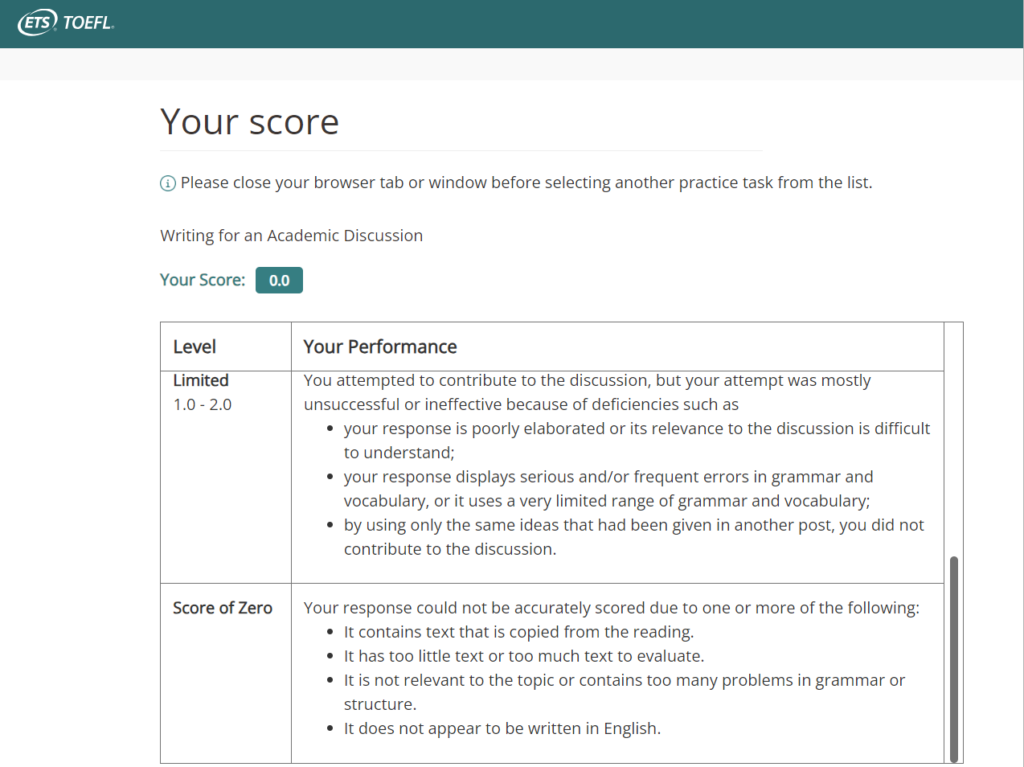In case you haven’t heard, the TOEFL has recently been revised. In this post we’re going to see the new format, discuss the changes and the reasoning them, and I’m also going to share my experience with the new writing task.
What’s the new format?
The short answer is that the test is more compact. Here’s a breakdown of each section based on what is provided on the ETS website:
Reading: 2 academic passages with 10 multiple-choice questions each, about 35 minutes
Listening: 3 academic lectures and/or discussions with 6 multiple-choice questions each AND 2 campus situation conversations with 5 questions each, about 36 minutes
Speaking: 1 independent speaking question and 3 integrated speaking questions, about 16 minutes
Writing: 1 Integrated Writing task (20 minutes) and 1 Writing for an Academic Discussion task (10 minutes)
What has changed and why?
The test now takes under 2 hours, which is much shorter than its main competitor, IELTS. This includes one fewer reading passage and one fewer listening passage. Pilot passages have been eliminated from both the reading and listening section.
I know that my attention span has certainly decreased with time, and a shorter test is something that I think many test takers are happy about. I imagine that TOEFL wants to position itself as a more attractive option to test takers that have a choice between TOEFL and IELTS.
As for the writing section, writing an entire essay is no longer required. The question taking its place requires test takers to write a post in response to a professor’s prompt about an academic topic. Two students provide their viewpoints on the topic, which gives test takers an idea of how they can respond. Here’s a sample question from the ETS website:

I was surprised by the change to the format, but Thom Kiddle suggested that this change is a way to combat the use of ChatGTP to produce essays. Even if students are monitored while taking the TOEFL at home, they can plug typical essay questions into ChatGTP and memorize them. It makes so much sense now when I look at it in retrospect.
How do I answer the new writing task?
ETS has released 28 practice tasks along with the scoring rubric. You can complete them online at this link and receive an AI score. (For the official test, AI along with a human will determine the score.)
I took three practice tasks to get a feel for the scoring criteria and how to provide an effective response.
Here is the first task I tried and my response. My full response didn’t fit on one screen, so I’ve included two screenshots:


Given that response, my score was a 4.0 out of 5. Here is what the website told me:

I wrote 149 words, and I thought it was a bit short. I thought that I needed more details to support my position.
For the next task I wrote more. Here was the prompt and my response:


The result? AI said I received a score of 0. It looks like my response was either too long (217 words), or I referred to the other students and their ideas too much.

I decided to try one last practice task. Here’s what it provided and how I responded:


This time I the response was scored as a 5 out of 5. It took some time, but it was like a Goldilocks experience of not enough, too much, and just right.

Conclusion
Overall, there isn’t much that test takers need to change with their preparation; the questions are all the same with the exception of the new writing task.
If you’d like to check out the changes for yourself, click here to access the official TOEFL website.
If you’d like to learn more about the elements of an effective response to this new TOEFL writing task, look for a new blog post soon. If you’d like personalized preparation for TOEFL, feel free to comment below or get in touch through my website contact form.



